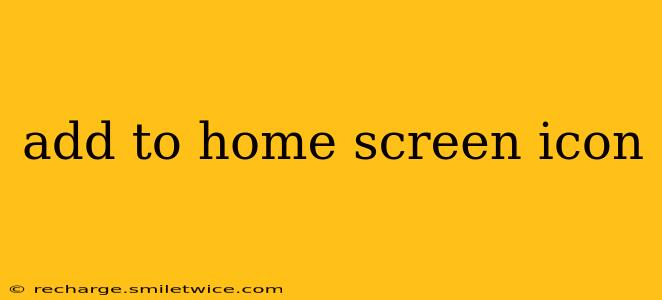Adding a custom icon to your home screen can personalize your device and make it easier to identify your favorite apps. This guide covers various methods for adding icons, addressing common questions and troubleshooting potential issues. We'll explore both Android and iOS devices, offering solutions for a variety of situations.
How Do I Add a Custom Icon to My Home Screen?
The process of adding a custom icon varies depending on your operating system (Android or iOS). Generally, it involves using a third-party app or shortcut, and sometimes requires a bit of technical know-how. Let's break it down:
Android: Adding Custom Icons
On Android, the method for adding custom icons often involves using a launcher app. These launchers replace your standard home screen interface, offering customization options, including icon packs and the ability to create shortcuts with custom images. Popular launchers include Nova Launcher, Action Launcher, and Microsoft Launcher.
Steps (using a launcher app – specifics may vary):
- Install a custom launcher: Download and install your preferred launcher from the Google Play Store.
- Choose an icon pack (optional): Many launchers allow you to download icon packs, offering themed sets of icons for various apps.
- Create a shortcut: Long-press on an app, then select "Create Shortcut." You might then have the option to choose a custom image for the shortcut icon from your gallery or the icon pack you selected.
- Customize the icon: Some launchers allow for advanced customization, including resizing and repositioning icons.
Note: Some Android versions might have built-in options for changing app icons, but this is not always the case. The launcher app method provides the most comprehensive control.
iOS: Adding Custom Icons
iOS offers less flexibility regarding custom icons compared to Android. While you can't directly replace app icons, you can create custom shortcuts that use images from your photo library. This method effectively creates a visually customized icon, but it's technically a shortcut to the original app.
Steps (using Shortcuts app):
- Create a Shortcut: Open the Shortcuts app.
- Add Action: Add the "Open App" action and select the app you want to customize.
- Add Icon: Choose a custom icon from your photo library.
- Add to Home Screen: Tap the "Add to Home Screen" button. You'll now have a shortcut with your custom image.
How Can I Change the Icon of a Specific App?
The ability to directly change the icon of a specific app depends on your operating system and device. As discussed above, Android offers more flexibility using launcher apps, while iOS requires the shortcut method.
What are the Best Apps for Customizing Home Screen Icons?
For Android, several excellent launcher apps facilitate icon customization. Nova Launcher, Action Launcher, and Microsoft Launcher are consistently highly-rated and provide extensive features for home screen personalization. For iOS, the built-in Shortcuts app is your primary tool for creating custom app shortcuts with alternative icons.
Can I Create My Own Custom Icons?
Yes, you can create your own custom icons. You’ll need image editing software (like Photoshop or GIMP) and some graphic design skills. Many websites and online tools also offer free or paid icon creation services. Remember to ensure your icons are appropriately sized for your device's resolution for optimal appearance.
What are the Advantages of Adding Custom Home Screen Icons?
Customizing your home screen icons offers several advantages:
- Improved aesthetics: A personalized home screen enhances the visual appeal of your device.
- Easier app identification: Unique icons make it quicker to locate your frequently used apps.
- Increased organization: Themed icons can help categorize and organize apps more effectively.
- Personal expression: Custom icons reflect your personality and style.
This guide provides a comprehensive overview of adding custom icons to your home screen. Remember to explore the features of your chosen launcher or shortcut app to unlock all its customization capabilities. Experimentation is key to achieving your desired personalized home screen look.
